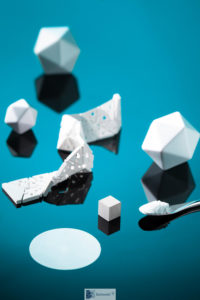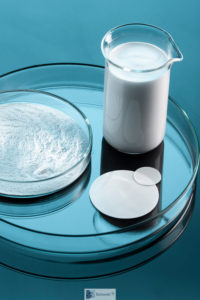The Manufacturing Challenge Overcome ?

Combining dissimilar materials inside dense ceramics has been a long-standing hurdle: conventional routes rarely deliver microstructural precision and preserved density. Additive manufacturing helped, but robocasting in air still constrains geometry and material pairings. The promising alternative—embedded 3D printing within a self-healing support—had proved difficult to translate to dense inorganic systems.
That changed when Imperial College London demonstrated an embedded route built on Baikowski’s SMA6.
In work titled Embedded 3D printing of microstructured multi-material composites and published in Matter (February 2024) , the team extruded complex architectures into a self-healing ceramic gel that yields to the nozzle and rapidly recovers, then—after controlled drying, debinding, and sintering—converts to dense alumina.
The study report defect-free, multi-material composites with sharp interfaces, opening design space for internal reinforcements and microchannels that conventional processing couldn’t reach.
SMA6 Properties Relevant to This Study?
Ultra-Fine Particle Engineering
 Baikalox® SMA6 (d₅₀ ≈ 0.2 µm) was selected for the work. Its tightly controlled, ultra-fine particle-size distribution supports tuning of gel viscosity, yield stress, and recovery—conditions the study leveraged so the nozzle passes cleanly and the matrix self-heals.
Baikalox® SMA6 (d₅₀ ≈ 0.2 µm) was selected for the work. Its tightly controlled, ultra-fine particle-size distribution supports tuning of gel viscosity, yield stress, and recovery—conditions the study leveraged so the nozzle passes cleanly and the matrix self-heals.
The approach uses gels with >25 vol% powder (matrix prepared at 7:3 wt/wt Al₂O₃:Pluronic), consistent with dense sintering of both matrix and inks. Packing was reported as uniform enough to reach ~4–6% porosity after firing, and dispersion control was observed to maintain sharp, porosity-free interfaces between embedded structures and the alumina matrix.
Powder Preparation and Gel Formulation
Before dispersion in Pluronic F127, SMA6 was sieved through a 100 µm plastic mesh to reduce agglomerates. With an appropriate dispersant (about 1 wt% relative to Al₂O₃), the powder forms a homogeneous, thermally reversible gel whose viscoelastic profile suited to to embedded printing.
How Does This Translate into Applications?
To validate the approach, the team demonstrated two use cases: co-sintered steel architectures that boost fracture energy without sacrificing strength, and sacrificial-graphite microchannels that deliver functional internal cooling in dense alumina.
🌟 1- Steel-Reinforced Alumina
Using SMA6-based matrices, steel architectures were embedded and co-sintered to dense composites. Reported values include:
- Flexural strength: 155–289 MPa
- Fracture toughness: 3.3–4.0 MPa·m¹ᐟ²
- Work of fracture: up to 3.6 kJ/m² for auxetic lattices (≈ two orders of magnitude above unreinforced alumina, ~30 J/m²)
Auxetic frameworks can steer cracks and distribute plastic deformation in steel, contributing to higher energy absorption while maintaining strength.
🌟 2- Advanced Thermal Management Systems
With sacrificial graphite printed inside the SMA6 matrix and burned out during sintering, the team produced three-dimensional microchannel arrays:
- Circular cross-sections approximately 200 μm diameter after sintering
- Wall thicknesses reduced to 50 μm between adjacent channels
- Cooling demonstration: in a 2.6 × 2.6 × 1.5 cm³ alumina cube, water at ~5.1 mL·min⁻¹ reduced top-center temperature from 119 °C to 62 °C in ~200 s
These results indicate practical routes to thermal-management components with complex internal geometrie.
How Did the Material Perform in the Study?
In short, the microstructure stayed tight and the printed features held their shape after firing. Overall density landed around 94–96% (≈ 4–6% porosity). Post-sinter, filaments remained in the ~70–260 µm range, and interfaces were sharp and porosity-free, as confirmed by SEM/EDX.
What Processing Parameters Were Reported?
Keep the window, and the parts keep their fidelity:
- Drying: 72 ± 3% RH, ~32 °C, ~2 weeks (on 16 × 16 × 16 mm cubes)
- Debinding: 1 °C·min⁻¹ → 350 °C (1 h); then 2 °C·min⁻¹ → 500 °C (2 h)
- Sintering: steel-reinforced parts to 1,450 °C (after a 600 °C step); microchannel parts to 1,550 °C
Which Conditions Make Embedded Printing Viable?
 Five things have to line up—and SMA6’s PSD/dispersion helps tick each box:
Five things have to line up—and SMA6’s PSD/dispersion helps tick each box:
- Viscoelastic match between ink and matrix
- Low matrix breaking stress so the nozzle can move freely
- Rapid matrix recovery so features don’t slump
- High ink yield stress to lock in filament geometry
- High inorganic content (matrix + inks) for dense, defect-free sintering
Where Could This Approach Adapt in Industry?

The method accommodated materials with very different properties—dense, hydrophilic steel and light, hydrophobic graphite—within the SMA6-based system, indicating potential versatility across material systems.
Target applications (as logical extensions):
- Structural ceramics (aerospace/defense/automotive) that could benefit where added toughness is valuable;
- Thermal management for electronics and energy systems that may leverage internal cooling;
- Multi-functional devices that combine structural and thermal roles;
- Architected composites with tailored mechanical responses.
Why Partner with Baikowski?
 Every Additive Manufacturing line has its own window. Baikowski’s wider portfolio includes specialized alumina grades for diverse processes.
Every Additive Manufacturing line has its own window. Baikowski’s wider portfolio includes specialized alumina grades for diverse processes.
We help you tune powder, rheology and sintering: custom formulations that match your process parameters, collaborative optimization to boost yield and performance, consistent quality batch after batch.
Frequently Asked Questions

Can this process work with other alumina grades besides SMA6?
In principle, similar outcomes may be achievable with other ultra-fine alumina grades, but each system requires its own rheology optimization. The key is a stable, high-solids gel with matched viscoelastic properties between matrix and inks. Our team can help evaluate the most suitable Baikowski grade for a given process window.
Why is particle size so critical for this application?
According to the study, a d₅₀ ≈ 0.2 µm supports precise control near the gel transition, enables high solids loading (>25 vol%), and helps limit interfacial mixing—factors associated with sharp boundaries after sintering.
How does this compare to conventional ceramic composite manufacturing?
The paper reports auxetic steel-reinforced alumina with work of fracture up to ~3.6 kJ·m⁻² while maintaining ~155–289 MPa flexural strength—performance that addresses the usual strength–toughness trade-off seen with conventional approaches.
What are the practical size limitations?
Feature size depends on nozzle diameter and matrix rheology. In the study, post-sinter filament diameters were ~70–260 µm, with microchannel walls ~50 µm at ~0.5 mm spacing. Finer features may be possible with smaller nozzles and tailored gel formulations.
Take the Next Step
 Developing advanced ceramic composites or exploring novel AM approaches? Baikowski offers comprehensive alumina solutions backed by dedicated technical support.
Developing advanced ceramic composites or exploring novel AM approaches? Baikowski offers comprehensive alumina solutions backed by dedicated technical support.
💬 Connect with our Experts and download our 3D Printing White Paper — powder selection and process optimization for ceramic AM (including SMA6 insights)
